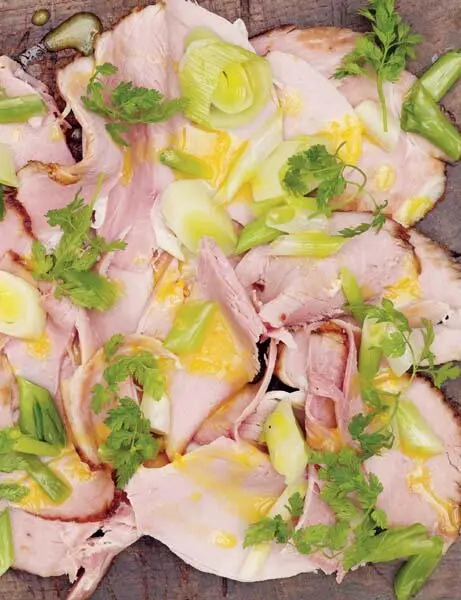Pinch of salt
1 bay leaf
1 medium leek, trimmed and outer leaves removed
8 spring onions
400g (14oz) York or any other roast ham, ready-sliced if you prefer
Chervil leaves, to garnish
For the glaze
4 tbsp English mustard
2 tbsp runny honey
150ml (6fl oz) rapeseed or extra-virgin olive oil
Zest of 2 oranges
4 tbsp white wine vinegar
Salt and black pepper
Until recently, one of the few places you could buy a real ‘York ham’ was Scott’s butchers in York, but sadly, after 150 years of trading, it is now closed. Despite this, the UK still produces the best pork in the world and we should make the most of it. This recipe is best served warm; however, if you choose to serve it cold, make just half the quantity of the glaze to drizzle over the ham in the final step.
Half fill a large saucepan with water, add the peppercorns, salt and bay leaf and bring to the boil. Once the water is boiling, add the leek whole (if it doesn’t fit, cut in half widthways). Reduce the heat and cook for 6–8 minutes on a gentle simmer. Add the spring onions and cook for a further 3 minutes, then drain the vegetables and allow to cool.
To make the glaze, place the mustard and honey in a bowl, slowly whisk in the rapeseed or olive oil, then add the orange zest and vinegar, season with salt and pepper and set aside.
If you wish to warm the meat, place the whole ham or the slices on a baking tray and spoon half of the glaze over the top. Put in a preheated oven at 170°C (325°F), Gas 3, for 1 hour if the ham is whole or, if it is ready-sliced, until heated through. Remove from the oven and, if necessary, carve the ham into slices.
Place the sliced ham on a board or platter, then slice the leek into 1cm (½in) rounds and the spring onion into bite-sized lengths. Arrange these on the ham, drizzle with the rest of the glaze, place a few chervil leaves on top and serve.

Scotch eggs with curried salad cream
Serves 4
8 small eggs and 4 medium eggs (reserve 2 for the salad cream)
450g (1lb) good-quality pork sausages or sausagemeat
300g (11oz) dried breadcrumbs, such as Japanese panko
1.2 litres (2 pints) vegetable oil, for deep-frying
For the salad cream
2 hard-boiled egg yolks (see above)
2 tsp English mustard
150ml (5fl oz) rapeseed oil or extra-virgin olive oil
1 tbsp white wine vinegar
75 ml (3fl oz) double cream
1 tbsp mild curry powder, or to taste
Salt and black pepper
We’re all kids at heart, so who wouldn’t love these delicious eggs? The curried salad cream adds a nice spicy touch and will keep for two days in the fridge, although it’s best used fresh.
Fill a large saucepan with water and bring to the boil. Place the eight small eggs and two of the medium eggs in the boiling water. Remove the eight small eggs after 2–3 minutes and the two medium eggs after 7–8 minutes. Run under cold water immediately to stop them cooking any further, then peel them whole, and set the two medium ones aside.
Remove the skin from the sausages (if using), then dip your hands in cold water and divide the meat into eight balls. With wet hands, press the centre of each ball to make a well. Place a small cooked egg in each well and carefully close the meat around it. Place them on a large plate in the fridge and leave for about 2 hours to firm up.
Place the two uncooked eggs in a shallow bowl and whisk with a fork. Pour the breadcrumbs onto a plate. Dip each Scotch egg in the whisked egg, then roll in the crumbs and return to the fridge for 30 minutes. Repeat the process until each egg has a double layer of crumbs.
Meanwhile, make the salad cream. Push the yolks from the two hard-boiled medium eggs through a sieve into a bowl, then beat in the mustard, season with salt and pepper and place in a blender or food processor. Alternatively, use a hand-held beater for whisking the ingredients together.
Continued overleaf…
Whisk in the rapeseed or olive oil while the machine is on, pouring in a few drops at a time. When smoothly amalgamated, whisk in the vinegar, again a little at a time, and then slowly add the cream. Add the curry powder and season with more salt and pepper, to taste, if needed.
If using a deep-fat fryer, heat the vegetable oil to 150°C (300°F) – not too hot or the eggs will explode and the meat will not cook through. Alternatively, fill a deep, heavy-based frying pan to a depth of 2cm (¾in) with oil and use a sugar thermometer to check that it has reached the correct temperature. Carefully lower the Scotch eggs into the oil and cook for 5–7 minutes.
When cooked, serve hot or cold, with salad cream on the side.
Serves 4
1.5kg (3lb 4oz) ham hocks
1 onion, peeled and roughly chopped
½ tsp black peppercorns
1 tsp salt
2 sprigs of rosemary
2 bay leaves
3 leaves of gelatine
6 tbsp chopped flat-leaf parsley
Extra salt and black pepper
Crusty bread, to serve
From the base of a pig’s leg bone, a ham hock is an inexpensive cut of meat that is often overlooked. There isn’t loads of meat on it, so you’ll need several for this recipe. Serve with cucumber pickle (see page 37) and a pile of crusty bread or warm boiled potatoes.
Place the ham hocks in a large, deep saucepan, along with the onion, peppercorns, salt, rosemary and bay leaves. Cover with water and bring to the boil, then reduce the heat and simmer for 2 hours. Remove from the heat and allow to cool in the pan.
Take the hocks from the pan and set aside. Strain the cooking liquid through a fine sieve and pour 250ml (9fl oz) of it into a saucepan set over a medium heat. Place the gelatine leaves in a bowl of cold water and soak for 5 minutes until pliable, then drain the water off and add the gelatine to the hot liquid. Stir well and allow to cool.
Remove the ham from the bones and cut into 2.5cm (1in) pieces, tearing if needed. Mix with the parsley and season lightly with salt and pepper. Line a glass bowl or terrine dish about 1.2 litres (2 pints) in size with a large piece of cling film and spread a quarter of the ham pieces over the base.
Spoon over some of the gelatine liquid, add another quarter of the ham and more gelatine, repeating for two further layers and pouring over the remaining gelatine with the final layer. Stretch cling film loosely over the top, then a layer of foil, and place in the fridge – on a plate, to catch any drips – for 2 hours with a weight or weights pressing on the top.
To serve, take the terrine from the fridge, remove the cling film and accompany with pickled cucumber and crusty bread.
Rhubarb and ginger syllabub
Serves 4
2 sticks of rhubarb (preferably forced variety), cut into lcm (½in) cubes
2.5cm (1in) piece of root ginger, peeled and chopped
4 tbsp caster sugar
Читать дальше













